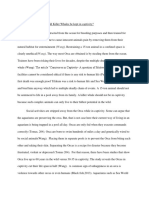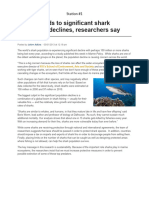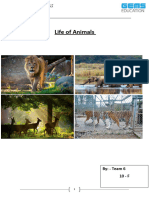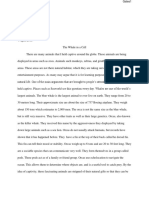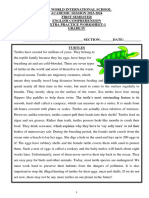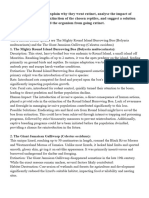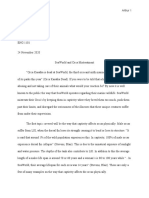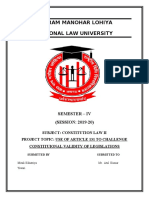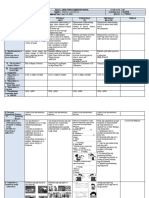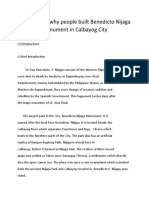Comprehension Question
Comprehension Question
Uploaded by
Ahmad Safuan Bin Mohd Sukri -Copyright:
Available Formats
Comprehension Question
Comprehension Question
Uploaded by
Ahmad Safuan Bin Mohd Sukri -Original Description:
Original Title
Copyright
Available Formats
Share this document
Did you find this document useful?
Is this content inappropriate?
Copyright:
Available Formats
Comprehension Question
Comprehension Question
Uploaded by
Ahmad Safuan Bin Mohd Sukri -Copyright:
Available Formats
Until recently, many people outside Australia had never heard of the quokka,
a Muppet-cute marsupial with an irresistible smile, despite its beady eyes and a tail
like a rat. This smiling marsupial is a favourite photo subject for tourists on West
Australia's Rottnest Island. People's selfies with the furry quokkas have charmed
the Internet. So what is the story behind the quokkas? Their smile has earned them 5
the title of the "happiest animals in the world".
First of all, quokkas prefer thick vegetation and their habitats are island
swamps, mainly on Rottnest Island and Bald Island. They can also be found in
eucalyptus forests and on riverbanks of the mainland. These social plant-eaters
hang out in clans, munch on swamp peppermint and other greens. They dig tunnels 10
through vegetation for napping and hiding. They even hop like kangaroos.
Rottnest Island is the only place where quokkas still come together in large
numbers. There are as many as 12,000 of them here, of fewer than 14,000 total in
the wild. According to the International Union for Conservation of Nature, quokkas
have to face extinction due to habitat destruction and human development. 15
Rottnest, meaning "rats' nest," got its name from a Dutch sea captain who observed
these animals in the early 1700s and described them as "a kind of rat as big as a
common cat."
Not surprisingly, quokkas have adapted nicely to the human presence. They
can be seen roaming freely on the streets. As skilled as raccoons, they scatter 20
rubbish in search for food. They also do not mind posing for people to take their
pictures. A marsupial expert and a zoologist at St. Petersburg State University in
Russia, Yegor Malaschichev, sees no harm in taking photos with quokkas but he
warns not to touch them because it is illegal. That also means no hugging the
animals, no matter how huggable they are. 25
Malaschichev also advises visitors not to feed the quokkas, especially with
what we think they may like to eat. “As an example, the animals will happily and
adorably nibble away at a visitor's sandwich. Unfortunately, the bread that sticks
between their teeth can cause an infection called lumpy jaw,” said Malaschichev,
who has received funding from National Geographic. He added, “it would be terrible 30
to cause premature death in one of these nice and adorable animals."
A conservation biologist, Sue Miller of the University of Western Australia
who has worked with the quokkas for several years, states that feeding them is a
bad idea. "People tend to feed them fries, bread or fruits, and the animals become
trusting of humans. This can cause problems.” She also said that there is always 35
the risk of being bitten because quokkas are wild animals. Indeed, they bite dozens
of people at Rottnest each year, usually children. However, injuries are not serious
and most likely occur accidentally when the animals snatch snacks from the
children’s fingers.
Human activities such as hunting and poisoning of these animals have 40
reduced their population. Since their introduction to Australia in the 1930s, foxes
have begun to hunt quokkas for food. Miller also says that the main threats to
quokkas today include animals like foxes and wild cats, land clearing, the risk of fire
and disease.
Australian animals have suffered too but quokkas are luckier than many. 45
However, they still need help, and this calls for the assistance of conservationists.
Their aim is to maintain the animals' current numbers and distribution. It has
focused mainly on controlling predators and better managing the quokkas' forest as
well as the island habitat. Therefore, in Rottnest, tourists are reminded not to harm
these animals 50
1. From paragraph 1, where can quokkas be found?
_________________________________________________________________________
2. From paragraph 2, what do quokkas feed on?
_________________________________________________________________________
3. From Paragraph 3,
a. which phrase means the ‘natural home is damaged’?
_________________________________________________________________________
b. how did the Dutch sea captain describe a quokka?
_________________________________________________________________________
4. From paragraph 4, what is the evidence to show that quokkas are not scared of humans?
_________________________________________________________________________
5. From paragraph 6, how can quokkas possibly hurt children?
_________________________________________________________________________
6. From paragraph 7, what does their in line 41 refer to?
_________________________________________________________________________
7. From paragraph 8, who have been asked to help preserve the population of quokkas?
_________________________________________________________________________
8. How can you show your love and care towards animals? Suggest two ways.
_________________________________________________________________________
The quokkas are facing extinction nowadays. .
Write a summary about the dangers they face and what humans should not do towards
them.
Your summary must:
be in continuous writing form (not in note form)
use materials from line 15 to line 50
not be longer than 130 words, including the 10 words given below
Begin your summary as follows:
On Rottnest Island, quokkas are facing extinction mainly due to….
You might also like
- Focus 3 Student's Book B1/B1+Document156 pagesFocus 3 Student's Book B1/B1+amine66% (29)
- Apturtlecasestudysept 78Document7 pagesApturtlecasestudysept 78api-32878930083% (6)
- Dukewriting Lesson3-AnswerDocument2 pagesDukewriting Lesson3-AnswerSalekin Mishu100% (1)
- Should Killer Whales Be Kept in Captivity - EssayDocument5 pagesShould Killer Whales Be Kept in Captivity - Essayapi-405718287No ratings yet
- Tafsir Bi Al-DirayahDocument1 pageTafsir Bi Al-DirayahRasyad KamalNo ratings yet
- 06 02 06 036 SDocument2 pages06 02 06 036 STodd KoenigNo ratings yet
- Argument EssayDocument9 pagesArgument Essayapi-301337806No ratings yet
- Hkdse Eng PP 1Document12 pagesHkdse Eng PP 1SCYeungNo ratings yet
- Fishing Leads To Significant Shark Population Declines, Researchers SayDocument8 pagesFishing Leads To Significant Shark Population Declines, Researchers Saycarmen.herinNo ratings yet
- Endangrd PDFDocument5 pagesEndangrd PDFdavidcosmin186832No ratings yet
- of SCR (2ka21cs040)Document13 pagesof SCR (2ka21cs040)Shashank MalagiNo ratings yet
- Pets You Cant Keep in QLDDocument28 pagesPets You Cant Keep in QLDjimmyrich1221No ratings yet
- Dupla 12.englishDocument3 pagesDupla 12.englishgeovanasousa20082008No ratings yet
- Progression 3 EssayDocument6 pagesProgression 3 Essayapi-242607982No ratings yet
- Animals in CaptivtyDocument14 pagesAnimals in Captivtyapi-509417653No ratings yet
- SAU 11 Aspect The Animal WorldDocument3 pagesSAU 11 Aspect The Animal WorldAsel AbdirakinNo ratings yet
- Whales in Captivity by David Kirby, A Journalist For Over 20 Years With Several Awards andDocument12 pagesWhales in Captivity by David Kirby, A Journalist For Over 20 Years With Several Awards andapi-291227828No ratings yet
- This House Believes Wild Animals Should Not Be Kept in CaptivityDocument7 pagesThis House Believes Wild Animals Should Not Be Kept in CaptivityLourleth Caraballa LluzNo ratings yet
- Wild Animals Should Not Be Kept in CaptivityDocument3 pagesWild Animals Should Not Be Kept in CaptivityLauren Halleran0% (1)
- Life of Animals in Zoo - 2020 - 91064Document11 pagesLife of Animals in Zoo - 2020 - 91064OmkarNo ratings yet
- Essay 3 Rough DraftDocument7 pagesEssay 3 Rough Draftapi-457039397No ratings yet
- Practice Material For Igcse EnglishDocument5 pagesPractice Material For Igcse EnglishRajesh Kp100% (3)
- Stuck in A HoleDocument8 pagesStuck in A HoleMontana QuarterlyNo ratings yet
- Ugyen PeljorDocument7 pagesUgyen PeljorUgyen PenjorNo ratings yet
- Should Animals Be Kept in Zoos?: Read The Following Passage Thoroughly!Document3 pagesShould Animals Be Kept in Zoos?: Read The Following Passage Thoroughly!Pande AdnyanaNo ratings yet
- Frogs of Victoria: A Guide to Identification, Ecology and ConservationFrom EverandFrogs of Victoria: A Guide to Identification, Ecology and ConservationNo ratings yet
- Pros Cons 2 of ZoosDocument3 pagesPros Cons 2 of Zoosapi-170235603No ratings yet
- Whale CaptivityDocument6 pagesWhale Captivityapi-404822230No ratings yet
- The Cane Toad: HistoryDocument2 pagesThe Cane Toad: HistoryringpieceNo ratings yet
- The Leatherback Sea TurtleDocument9 pagesThe Leatherback Sea Turtleedclausen1No ratings yet
- Rusty Crayfish Report Edited Final For MarkingDocument5 pagesRusty Crayfish Report Edited Final For Markingapi-271433243No ratings yet
- Herons, Egrets and Bitterns: Their Biology and Conservation in AustraliaFrom EverandHerons, Egrets and Bitterns: Their Biology and Conservation in AustraliaRating: 5 out of 5 stars5/5 (1)
- When Whales Walked Worksheet Part 5 1Document2 pagesWhen Whales Walked Worksheet Part 5 1api-284221392No ratings yet
- Comprehension TurtlesDocument2 pagesComprehension TurtlesTasneem BabatNo ratings yet
- UWRT Porfolio With CommentsDocument5 pagesUWRT Porfolio With CommentsTaylor MurrmannNo ratings yet
- Are Zoos A Good Thing?Document2 pagesAre Zoos A Good Thing?Даша Мар'яшNo ratings yet
- Debate Examples To Help You Get Started - PDF SampleDocument1 pageDebate Examples To Help You Get Started - PDF SampleHsin Ju LeeNo ratings yet
- Blue Whale: © Primary Leap Ltd. 2010Document2 pagesBlue Whale: © Primary Leap Ltd. 2010Todd KoenigNo ratings yet
- Axolotl Paper For Ms Life Science - Gabriel 1Document11 pagesAxolotl Paper For Ms Life Science - Gabriel 1api-205328583100% (1)
- UWRT Portfolio-1Document9 pagesUWRT Portfolio-1Taylor MurrmannNo ratings yet
- Why The World Needs Zoos - DR Dave HoneDocument4 pagesWhy The World Needs Zoos - DR Dave Honedubois antoineNo ratings yet
- Dayanna GayossoDocument8 pagesDayanna Gayossoapi-443043122No ratings yet
- Dupla 4. EnglishDocument2 pagesDupla 4. Englishgeovanasousa20082008No ratings yet
- SeaWorldOpenLetterRebuttal OPSDocument3 pagesSeaWorldOpenLetterRebuttal OPSChris JosephNo ratings yet
- Canadian Government Sets Hunt Quota of 400,000 Seals: International Fund For Animal Welfare IfawDocument6 pagesCanadian Government Sets Hunt Quota of 400,000 Seals: International Fund For Animal Welfare IfawjoeyOCNo ratings yet
- Geographical Issue Essay - 2Document14 pagesGeographical Issue Essay - 2Charlotte ConnerNo ratings yet
- Week 2Document6 pagesWeek 2joeyOCNo ratings yet
- Arc 006 RSW Zoological Theme ParkDocument11 pagesArc 006 RSW Zoological Theme ParkAngelica MercadoNo ratings yet
- Thesis Recommendations On Work - NEW NO INDENTS AND EDITSDocument130 pagesThesis Recommendations On Work - NEW NO INDENTS AND EDITSArley CatajoyNo ratings yet
- Personal StatementDocument1 pagePersonal Statementrg[ghththh gergaegNo ratings yet
- ??????? ?? ???-? ????-?Document6 pages??????? ?? ???-? ????-?ravichandra dasariNo ratings yet
- Axolotl ConservationDocument3 pagesAxolotl ConservationMichael SmithNo ratings yet
- Why Imprison Animals in The ZooDocument3 pagesWhy Imprison Animals in The ZooMichelle ChristinaNo ratings yet
- Comp 1 EssayDocument6 pagesComp 1 Essayapi-610304787No ratings yet
- Couse WorkDocument3 pagesCouse WorkluciaolleriglesiasNo ratings yet
- Why Dogs Eat Poop: Gross but True Things You Never Knew About AnimalsFrom EverandWhy Dogs Eat Poop: Gross but True Things You Never Knew About AnimalsRating: 3.5 out of 5 stars3.5/5 (5)
- Saving Turtles: A Kids' Guide to Helping Endangered CreaturesFrom EverandSaving Turtles: A Kids' Guide to Helping Endangered CreaturesNo ratings yet
- Hagg - Life of AntonyDocument21 pagesHagg - Life of AntonyAnonyymousssNo ratings yet
- Methodology Used in Fdi in IndiaDocument3 pagesMethodology Used in Fdi in IndiaAakriti PatwaryNo ratings yet
- Use of Article 131 Is Questioning Constiutional Validity of LawsDocument14 pagesUse of Article 131 Is Questioning Constiutional Validity of LawsribopeNo ratings yet
- Indian LogosDocument58 pagesIndian Logosadisantkapoor100% (1)
- 2Document2 pages2Gioti KaterinaNo ratings yet
- Detailed Lesson Plan For Grade 10 Q4 W1Document11 pagesDetailed Lesson Plan For Grade 10 Q4 W1Jamaica Rose BalbinNo ratings yet
- HRM and Labour LawsDocument24 pagesHRM and Labour LawsDipti TyagiNo ratings yet
- Specific Gravity of Coarse Aggregate & FINE AGGREGATEDocument39 pagesSpecific Gravity of Coarse Aggregate & FINE AGGREGATESANJAY KUMAR SINGH63% (8)
- A Study On Consumer Psychology Towards Homeopathy Medicines: Shanlax International Journal of Arts, Science & HumanitiesDocument4 pagesA Study On Consumer Psychology Towards Homeopathy Medicines: Shanlax International Journal of Arts, Science & Humanitiesgoodboy guduNo ratings yet
- The Heidi Chronicles By: Wendy Wasserstein - 1990Document2 pagesThe Heidi Chronicles By: Wendy Wasserstein - 1990Carter M.No ratings yet
- Service Quality and User Satisfaction Questionnaire - Library ContextDocument1 pageService Quality and User Satisfaction Questionnaire - Library ContextRich KishNo ratings yet
- Mapeh3 - Q4 - Week 1Document10 pagesMapeh3 - Q4 - Week 1Virgil Acain GalarioNo ratings yet
- Oral CommDocument4 pagesOral CommRobert Banaria BasinangNo ratings yet
- 08 - Test Ôn Thi Hsg Anh 9 - Tuần 7 - Tháng 10 - 2024Document8 pages08 - Test Ôn Thi Hsg Anh 9 - Tuần 7 - Tháng 10 - 2024linhchi.nx2010No ratings yet
- 028 Qa EndpointsDocument7 pages028 Qa Endpointsmaricela hernandez garciaNo ratings yet
- Smart Home Technology: Hands-0N Technical DemonstrationDocument64 pagesSmart Home Technology: Hands-0N Technical DemonstrationSaiPrasad AvulamNo ratings yet
- AnovaDocument23 pagesAnovaHimanshu Jain100% (1)
- Cash Flow StatementDocument18 pagesCash Flow StatementBrian Reyes Gangca50% (4)
- ICICI Prudential Advertisement Review and Song Par Bande Acche HaiDocument3 pagesICICI Prudential Advertisement Review and Song Par Bande Acche HaiVaibhav WalkeNo ratings yet
- Shannon's D&D House Rules v08 (BFRPG)Document6 pagesShannon's D&D House Rules v08 (BFRPG)shannon68No ratings yet
- Free Energy-Fact or Fiction?: by Maurice CotterellDocument4 pagesFree Energy-Fact or Fiction?: by Maurice Cotterellfsilassie8012No ratings yet
- 3 Egyptosophy and Modern FreemasonryDocument10 pages3 Egyptosophy and Modern Freemasonryblackhole93No ratings yet
- ResearchDocument7 pagesResearchMa Noressa Mañoso Saludar100% (1)
- Technically, A Word Is A Unit of Language That Carries Meaning and Consists of One orDocument7 pagesTechnically, A Word Is A Unit of Language That Carries Meaning and Consists of One orDoni Setiawan sinagaNo ratings yet
- 2018 Study GuideDocument154 pages2018 Study GuideAlainNo ratings yet
- Family of Prophet Muhammad (SAW)Document23 pagesFamily of Prophet Muhammad (SAW)Ahmad Sharief Bin JaylaniNo ratings yet
- First Division (G.R. NO. 180832: July 23, 2008) Jerome Castro, People of The Philippines, Resolution CoronaDocument7 pagesFirst Division (G.R. NO. 180832: July 23, 2008) Jerome Castro, People of The Philippines, Resolution CoronaTaisho Narval NudasNo ratings yet



